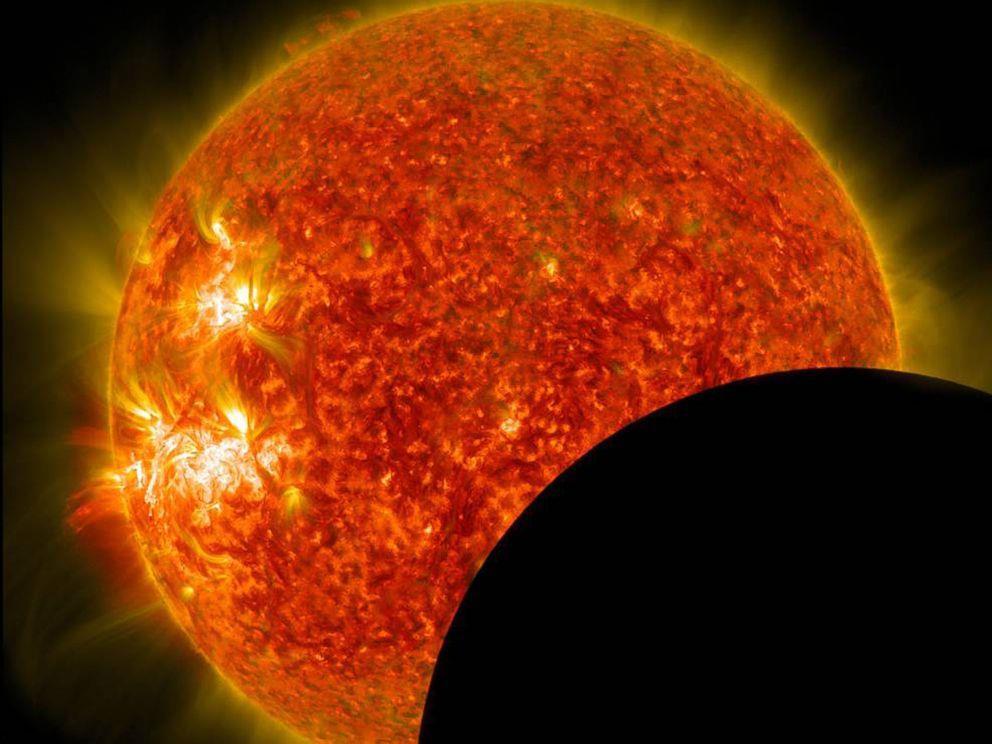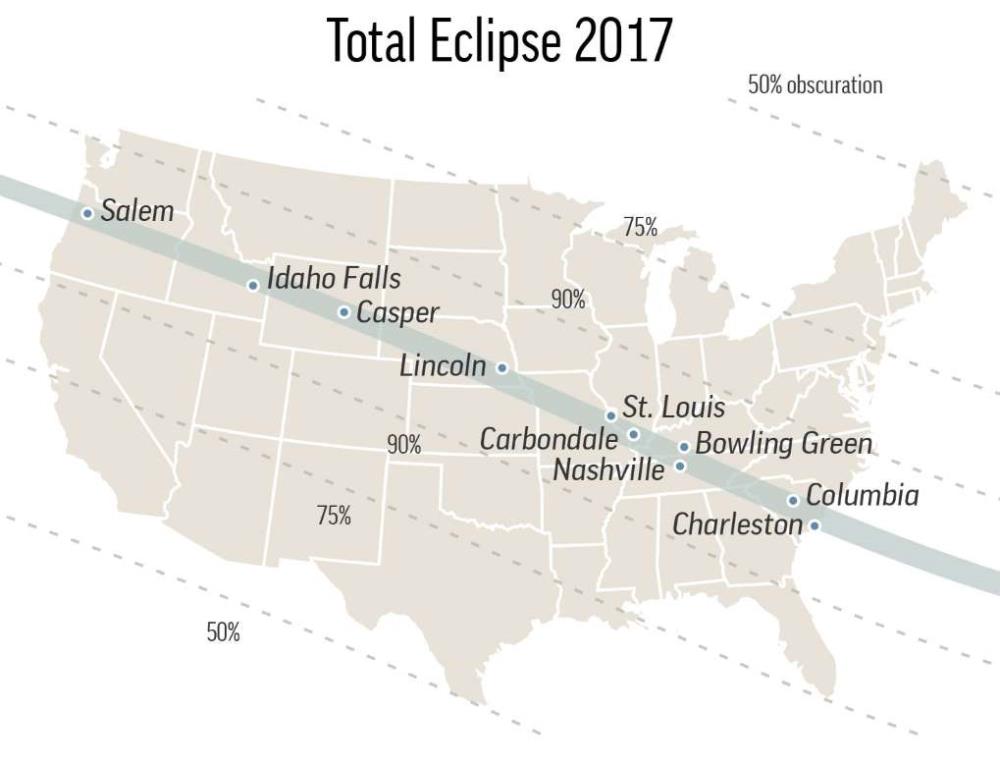August 21, 2017
Americans gazed in wonder through telescopes, cameras and disposable protective glasses Monday as the moon blotted out the midday sun in the first full-blown solar eclipse to sweep the U.S. from coast to coast in nearly a century.

August 21, 2017
Americans gazed in wonder through telescopes, cameras and disposable protective glasses Monday as the moon blotted out the midday sun in the first full-blown solar eclipse to sweep the U.S. from coast to coast in nearly a century.

It promised to be the most observed and photographed eclipse in history, with millions staking out prime viewing spots and settling into lawn chairs to watch, especially along the path of totality — the line of shadow created when the sun is completely obscured.
The shadow — a corridor just 60 to 70 miles (96 to 113 kilometers) wide — came ashore in Oregon and then began racing diagonally across the continent to South Carolina, with darkness lasting only about two to three minutes in any one spot.
“The show has just begun, people! What a gorgeous day! Isn’t this great, people?” Jim Todd, a director at the Oregon Museum of Science and Industry, told a crowd of thousands at an amphitheater in Salem, Oregon, as the moon seemed to take an ever-bigger bite out of the sun and temperature soon dropped noticeably.

TOPSHOT – The "diamond ring effect" is seen during a total solar eclipse as seen from the Lowell Observatory Solar Eclipse Experience on August 21, 2017 in Madras, Oregon. Millions will be able to witness the total eclipse that will touch land in Oregon on the west coast and continue through South Carolina on the east coast. / AFP PHOTO / STAN HONDA (Photo credit should read STAN HONDA/AFP/Getty Images)
The "diamond ring effect" is seen during a total solar eclipse as seen from the Lowell Observatory Solar Eclipse Experience on Aug. 21, 2017 in Madras, Oregon.
With 200 million people within a day’s drive from the path of totality, towns and parks braced for monumental crowds. Clear skies beckoned along most of the route, to the relief of those who feared cloud cover would spoil this once-in-a-lifetime moment.
“It’s like nothing else you will ever see or ever do,” said veteran eclipse-watcher Mike O’Leary of San Diego, who set up his camera along with among hundreds of other amateur astronomers gathered in Casper, Wyoming. “It can be religious. It makes you feel insignificant, like you’re just a speck in the whole scheme of things.”
Astronomers were giddy with excitement. A solar eclipse is considered one of the grandest of cosmic spectacles.
NASA solar physicist Alex Young said the last time earthlings had a connection like this to the heavens was during man’s first flight to the moon, on Apollo 8 in 1968. The first, famous Earthrise photo came from that mission and, like this eclipse, showed us “we are part of something bigger.”

Chart shows the path of the 2017 eclipse across the United States; 3c x 3 3/4 inches; 146 mm x 95 mm; – Associated Press
With half hour to go before totality, NASA’s acting administrator, Robert Lightfoot, enjoyed the moon’s “first bites out of the sun” from a plane flying over the Oregon coast and declared it “just an incredible view.”
“I’m about to fight this man for a window seat,” Lightfoot said, referring to a fellow NASA scientist.
The Earth, moon and sun line up perfectly every one to three years, briefly turning day into night for a sliver of the planet. But these sights normally are in no man’s land, like the vast Pacific or Earth’s poles. This is the first eclipse of the social media era to pass through such a heavily populated area.
The moon hasn’t thrown this much shade at the U.S. since 1918, during the country’s last coast-to-coast total eclipse. In fact, the U.S. mainland hasn’t seen a total solar eclipse since 1979 — and even then, only five states in the Northwest experienced total darkness.
“It’s really, really, really, really awesome,” said 9-year-old Cami Smith as she watched the fully eclipsed sun from a gravel lane near her grandfather’s home at Beverly Beach, Oregon.
Scientists said the total eclipse would cast a shadow that would race 2,600 miles (4,200 kilometers) through 14 states, entering near Lincoln City, Oregon, at 1:16 p.m. EDT, moving diagonally across the heartland over Casper, Wyoming, Carbondale, Illinois, and Nashville, Tennessee, and then exiting near Charleston, South Carolina, at 2:47 p.m. EDT.
Shawnee National Forest in southern Illinois was in line to see the longest stretch of darkness: 2 minutes and 44 seconds.
All of North America was on track to get at least a partial eclipse, along with Central America and the top of South America.
Joe Roth, an amateur photographer, traveled south from the Chicago area to Alto Pass, Illinois, to catch his first total solar eclipse — on his 62nd birthday, no less. He said the stars aligned for him — “a Kodak moment for me to cherish and experience.”
Kim Kniseley drove overnight from Roanoke, Virginia, arriving in Madisonville, Tennessee, before dawn to get a parking spot at Kefauver Park, where by sunrise dozens of folks had claimed benches and set up tents.
He said he could have stayed home in Roanoke and seen a partial eclipse of 90 percent, but that would have been like “going to a rock concert and you’re standing in the parking lot.”
Hoping to learn more about the sun’s composition and activity, NASA and other scientists watched and analyzed from telescopes on the ground and in orbit, the International Space Station, airplanes and scores of high-altitude balloons beaming back live video.
Citizen scientists also planned to monitor animal and plant behavior as daylight turned into twilight and the temperature dropped. Thousands of people streamed into the Nashville Zoo just to watch the animals’ reaction.
Scientists warned people not to look into the sun without protection, except when the sun is 100 percent covered. Otherwise, to avoid eye damage, keep the solar specs on or use pinhole projectors that can cast an image of the eclipse into a box.
The next total solar eclipse in the U.S. will be in 2024. The next coast-to-coast one will not be until 2045.
Courtesy/Source: AP















































































































